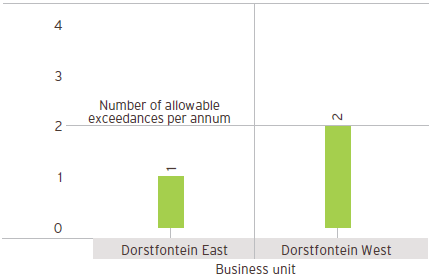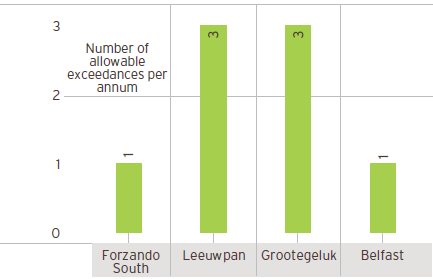Integrated report 2019

Highlights
Exxaro remains exposed to the risk of deteriorating air quality, which is affected by dust and other pollutants such as particulate matter (PM), including PM10 and PM2.5 from opencast operations. To mitigate this risk, we focus on
During 2019, we focused on going beyond compliance and implementing our reviewed air quality management system at various business units. This process included air quality impact assessments and redesigning our air quality monitoring programmes at each business unit. Air quality awareness and educational campaigns were undertaken in our host communities with the objective of improving stakeholder awareness of air pollution. In 2020, we will continue improving and reviewing our air quality management systems to ensure compliance and a reduction in emissions.
Air quality management initiatives
| Objectives | Critical success factors | Method | Deadline | |
| Reviewing and implementing air quality management systems | Reduction in dust fallout and PM10 levels will be managed by dust fallout monitoring and PM10 monitoring | Dust fallout levels and PM10 concentrations will be reduced by applying best practice mitigation measures such as wet suppression and chemical suppression of dust including research and development of new dust suppression and air pollution mitigation technologies | Second quarter of 2020 | |
Long-term and short-term goals for air quality management
| Goal | Target | Progress | |
| Continuous dust fallout monitoring at all business units | Ongoing | Dust fallout monitoring undertaken as a priority at all business units including the Belfast project | |
| Initiating and continuously monitoring PM10 at all business units | Ongoing | PM10 monitoring initiated at some business units and the Belfast project site | |
| Meteorological monitoring to ensure availability of surface data for temperature, wind direction, wind speed, among others, for dispersion modelling, baseline characterisation, ambient monitoring, including dust fallout monitoring and reporting, among others | Fourth quarter of 2020 | Meteorological stations installed at some business units | |
| Ensuring compliance with South African dust fallout limits, air quality standards and guidelines | Ongoing | Most business units currently monitor dust fallout and PM10 and results are assessed for compliance with National Dust Control Regulations and National Ambient Air Quality Standards for PM10 | |
| Air quality awareness and educational campaigns among various stakeholders | Second quarter of 2020 | Stakeholder engagement on air quality undertaken in some communities | |

Opencast mining activities, such as blasting, drilling, crushing and screening, vehicle convoys, materials handling and wind erosion of exposed operational areas, unavoidably generate dust. We consistently strive to enhance our mitigation measures for activities that contribute significantly to dust so that we reduce the impacts on sensitive receptors and the environment. The following mitigation measures are in place at our operations:
All our mining operations monitor dust fallout rates and the results are assessed against the residential and non-residential limits in terms of National Dust Control Regulations. While our operations are required to comply with non-residential limits, some are close to residential areas or sensitive receptor areas. The goal is therefore to minimise the impact of our operations on nearby residents. In 2019, the dust fallout rate at all operations complied with the regulated residential and non-residential limits.
Dust fallout
| Target | 2019 | 2018 | 2017 | |||
|---|---|---|---|---|---|---|
| Coal: 300mg/m2/day | 206 | 184 | 172 |
| Number of exceedances of the residential limit (January to December 2019) |
Number of exceedances of the non-residential limit (January to December 2019) |
|
 |
 |